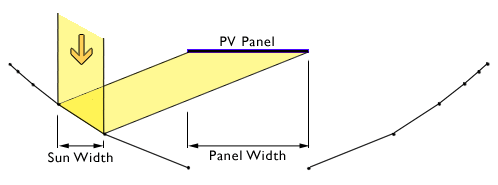I have been playing with solar-power designs in my head for a several years now. I started out looking into solar panels but where I live it’s not very cost-effective as the sun is never directly overhead. It seems that the traditional “solution” to having fewer full-sun-hours per day is to just buy more solar panels. I thought this was pretty wasteful since we never get the 1000W/m^2 that the panels are rated for.
How about using mirrors to reflect more sunlight onto a panel?
Since mirrors are cheaper (or can be) than solar panels, this seemed like the obvious solution, and indeed many companies are exploring variations on this theme. This is OK, but runs into a few issues- one being that each mirror reflecting sunlight onto a panel is also diluting the sunlight:
 Shown above, the “sun width” is narrower than the panel itself: in the highlighted path it’s a ratio of 45 to 120 or about 37% original intensity. To compensate for this one can simply use a lot of mirrors- the diagram shows a total of 10 flat mirrors each at the correct angle and width to fully illuminate the panel. If we assume a square solar panel, it achieves about 3 times the sunlight of simply pointing the panel directly at the sun. Add ten more mirrors perpendicular to the set shown and you have a 6-fold concentration:
Shown above, the “sun width” is narrower than the panel itself: in the highlighted path it’s a ratio of 45 to 120 or about 37% original intensity. To compensate for this one can simply use a lot of mirrors- the diagram shows a total of 10 flat mirrors each at the correct angle and width to fully illuminate the panel. If we assume a square solar panel, it achieves about 3 times the sunlight of simply pointing the panel directly at the sun. Add ten more mirrors perpendicular to the set shown and you have a 6-fold concentration:

This brings me to the second issue – heat. Solar panels are unfortunately less efficient the hotter they are. If I concentrate more sunlight onto the panel than it is rated for not only do I void the warranty but it produces less power. This led me to a bunch a schemes to actively manage the concentration which added too much complexity (and therefor cost) to the design. So rather than working against the sun’s heat, I started looking for ways to use it to my advantage. That’s when I turned to parabolic troughs- more on that soon.
Software Side Effects:
solar3d – A Google SketchUp Plug-in that draws the needed reflectors for a given panel size (copy to your plugin directory)